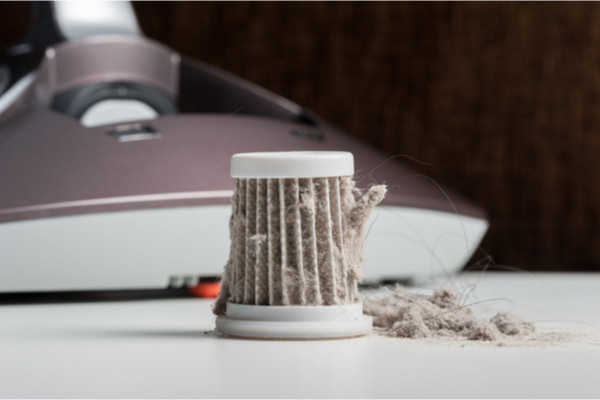Are your allergies driving you crazy this time of year? There are a whole slew of common household errors that could be upping your allergen ante. Here’s how to control the dust, mold, pollen and other contaminants that are making you sneeze.
1. Wearing Shoes Inside the House. Not only is wearing shoes indoors a health risk, but it can also increase allergens. Wet leaves bring in mildew, and pollutants from grass often get trapped on the bottom of shoes. Take your shoes off outside, or put them in a washable tray as soon as you walk in the door.
2. Not Wiping Down Your Handbags and Backpacks. Just think about all of the floors that your backpack, briefcase or purse touches in the span of a single day. Gross, right? Instead of bringing all that bacteria into your home, sanitize your bag with a disinfectant wipe and then hang it up in your entryway or closet.
3. Keeping the Temp Too High. Dust mites and mold love to live in warm climates. Keep your thermostat around 70 degrees to help keep them at bay.
4. Vacuuming Without a HEPA Filter. Use HEPA (high-efficiency particulate air) filters to prevent tiny particles of dust from being blown back out into the air.
5. Forgetting to Change the Vacuum Filter. Changing the filter is an essential part of keeping dust out of the air and preserving the life of the machine. Change the filter once it’s showing wear and tear or every six months if you’re using a HEPA filter.
6. Forgetting to Change the AC Filters. Never run your heating or air conditioning system without filters, and be sure to change them at least every three months.
7. Not Keeping a Barrier Between You and Your Bedding. Use zippered dust-proof casings for pillows and mattresses. The pore space of such casings is so small that dust mites and their waste products can’t get through.
8. Too Many Textiles. Carpeting, rugs, pillows, upholstered headboards and chairs are all dust catchers. Consider minimizing furnishings in living and sleeping areas for an easier-to-dust environment.
9. Burning the Wrong Candles. When was the last time you checked the label on your favorite scented candle? Though they smell divine, scented paraffin candles can release foul toxins like toluene and benzene, which have been linked to asthma and other lung conditions. Consider switching to candles containing beeswax or soy, which are safer and more natural.
10. Not Ventilating Your Bathroom. Running the exhaust fan (and making sure it’s vented to the outdoors) helps remove moisture from this naturally humid room.
11. Not Replacing Your Shower Curtain Liner. Mold and mildew love to grow on our shower curtain liners. When yours is starting to look like it’s in bad shape, toss it in the washer or replace it with a new one.
12. Overlooking Your Shower Head. While you’re deep cleaning the bathroom, don’t forget to disinfect your shower head; several studies have revealed that dirty shower heads can host Mycobacterium avium, a bacteria linked to pulmonary diseases. We suggest filling a plastic bag with white vinegar, wrapping your shower head in the bag and leaving it to soak for about an hour.
13. Ignoring Your Bathmat. Think about it. You step onto your bathmat completely wet on the daily. To keep it fresh (and to keep mildew away), hang it to dry after every use, and stick it in the washer once a week.
14. Not Washing Your Makeup Brushes. We know that cleaning your makeup brushes and face sponges feels like such a chore, but these tools can harbor bacteria and lead to breakouts or more serious skin conditions. Use dish soap or baby shampoo to wash them at least once a week.
15. Using That Sponge Over and Over Again. Sponges are porous, perpetually damp and notoriously pick up bacteria like salmonella and listeria like nobody’s business. Replace yours about every two weeks or, better still, switch to a plastic or silicone brush.
16. Not Cleaning Out Your Coffee Maker. As much as we hate to admit it, we’re all guilty of not cleaning our coffee makers on a regular basis. To prevent mold and bacteria from building up inside, wash removable parts with dish soap and then run white vinegar through the water tank.
17. Not Attending to Your Gutters. Leaky gutters can cause excessive moisture to enter your basement or crawl space. If you don’t have covered gutters, frequent litter removal is a must year-round.
18. Avoiding Protective Wear While Gardening. Even if you aren’t highly allergic to pollen, it can still irritate your eyes, nose and throat. To prevent this, always wear a mask and gloves while working in the yard.
19. Change Your Water Filter. While you rely on your water filter to clean your next cup, make sure you do the same. You don’t want buld up to grow and make the water you drink unsafe. Keep close watch on the filter status and have spare filters ready to go when it’s time to change.
20. Clean Your Door Knobs. Don’t forget to clean one of the germiest spots in your house: the door knobs. Every guest and member of the household grabs them. And while hopefully they’re washing their hands, these spots will still pick up germs.
—
Photo Credit: Nor Gal / Shutterstock.com
